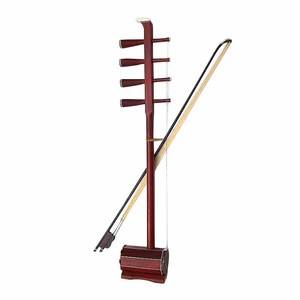The structure of the four-hued
Sihu is often made of mahogany and red sandalwood. The barrel is mostly octagonal, covered with python skin or cowhide. The peg and the shaft hole have no taper. The tension of the string is used to compress the shaft hole to fix it, and some are still on the rod. , The drum is inlaid with luotian patterns for decoration, and the thin bamboo system uses the horsetail as the bow.

Bass Sihu, also known as Big Sihu and Haolaibao Sihu, is widely popular in pastoral and semi-agricultural and semi-pastoral areas in Inner Mongolia Autonomous Region. The Sihu is composed of seven parts: the qin barrel, the qin handle, the qin shaft, the qin string, the qin jin, the qin bow and the qin code.
So far, it has a history of hundreds of years, and it is an indispensable folk instrument for rap and singing Haolaibao, Mongolian Qinshu, and singing Mongolian folk songs.
The specifications of the Sihu used by the famous Sihu performer Suma for solo performance are as follows: the qin barrel is oval, the barrel length is 20.5 cm, the front of the barrel is covered with thin cowhide, the barrel height is 10.5 cm, and the barrel width is 12 cm. The total length of the piano bar is 100 cm, the distance between the jins and the barrel is 42.5 cm, and the length of the bow is 50 cm.
In the Palace Museum in Beijing, there is a violin in the collection of the Qing Palace. The material and shape of the violin are quite unique. 11.5 cm, 10.7 cm high, 0.4 cm thick, with tortoiseshell trim, 0.6 cm wide, with a frame on the inside of the rear opening of the barrel, and a sound hole in the center with a diameter of 4.3 cm.
The qin stem is cylindrical, made of spotted bamboo, with a length of 88.3 cm. The upper end of the qin head is decorated with an animal head, which is carved from red sandalwood, and the head is 9.6 centimeters long.
The upper part of the piano bar is set with four axes, all on the right side, with a length of 15.2 cm. The lower end of the qin rod passes through and is exposed outside the qin barrel, which is used for tying the strings, and is decorated with yellow silk tassels. The bridge is placed in the center of the panel. The two ponytails of the thin bamboo series are the bows, the bows have a large curvature, and the bows are 32 cm long. This qin was made in the Qing Dynasty and was used in the ensemble music of the imperial court.
 渝公网安备 50010702504639号
渝公网安备 50010702504639号